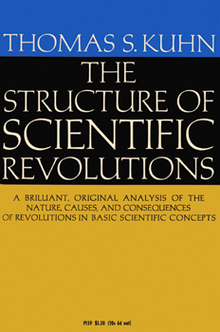 Cover of the first edition | |
| Author | Thomas S. Kuhn |
|---|---|
| Cover artist | Ted Lacey |
| Language | English |
| Subject | History of science |
| Publisher | University of Chicago Press |
Publication date | 1962 |
| Publication place | United States |
| Media type | Print (hardcover and paperback) |
| Pages | 264 |
| ISBN | 9780226458113 |
| 501 | |
| LC Class | Q175.K95 |
The Structure of Scientific Revolutions is a book about the history of science by the philosopher Thomas S. Kuhn. Its publication was a landmark event in the history, philosophy, and sociology of science. Kuhn challenged the then prevailing view of progress in science in which scientific progress was viewed as "development-by-accumulation" of accepted facts and theories. Kuhn argued for an episodic model in which periods of conceptual continuity and cumulative progress, referred to as periods of "normal science", were interrupted by periods of revolutionary science. The discovery of "anomalies" accumulating and precipitating revolutions in science leads to new paradigms. New paradigms then ask new questions of old data, move beyond the mere "puzzle-solving"[1] of the previous paradigm, alter the rules of the game and change the "map" directing new research.[2]
For example, Kuhn's analysis of the Copernican Revolution emphasized that, in its beginning, it did not offer more accurate predictions of celestial events, such as planetary positions, than the Ptolemaic system, but instead appealed to some practitioners based on a promise of better, simpler solutions that might be developed at some point in the future. Kuhn called the core concepts of an ascendant revolution its "paradigms" and thereby launched this word into widespread analogical use in the second half of the 20th century. Kuhn's insistence that a paradigm shift was a mélange of sociology, enthusiasm and scientific promise, but not a logically determinate procedure, caused an uproar in reaction to his work. Kuhn addressed concerns in the 1969 postscript to the second edition. For some commentators The Structure of Scientific Revolutions introduced a realistic humanism into the core of science, while for others the nobility of science was tarnished by Kuhn's introduction of an irrational element into the heart of its greatest achievements.
- ^ Kuhn 1962, pp. 35–42.
- ^ Kuhn (1996): asking new questions of old data on pages 139, 159; moving beyond "puzzle-solving" on pages 37, 144; change in rule sets on pages 40, 41, 52, 175; change in the direction or "map" of research on pages 109, 111.